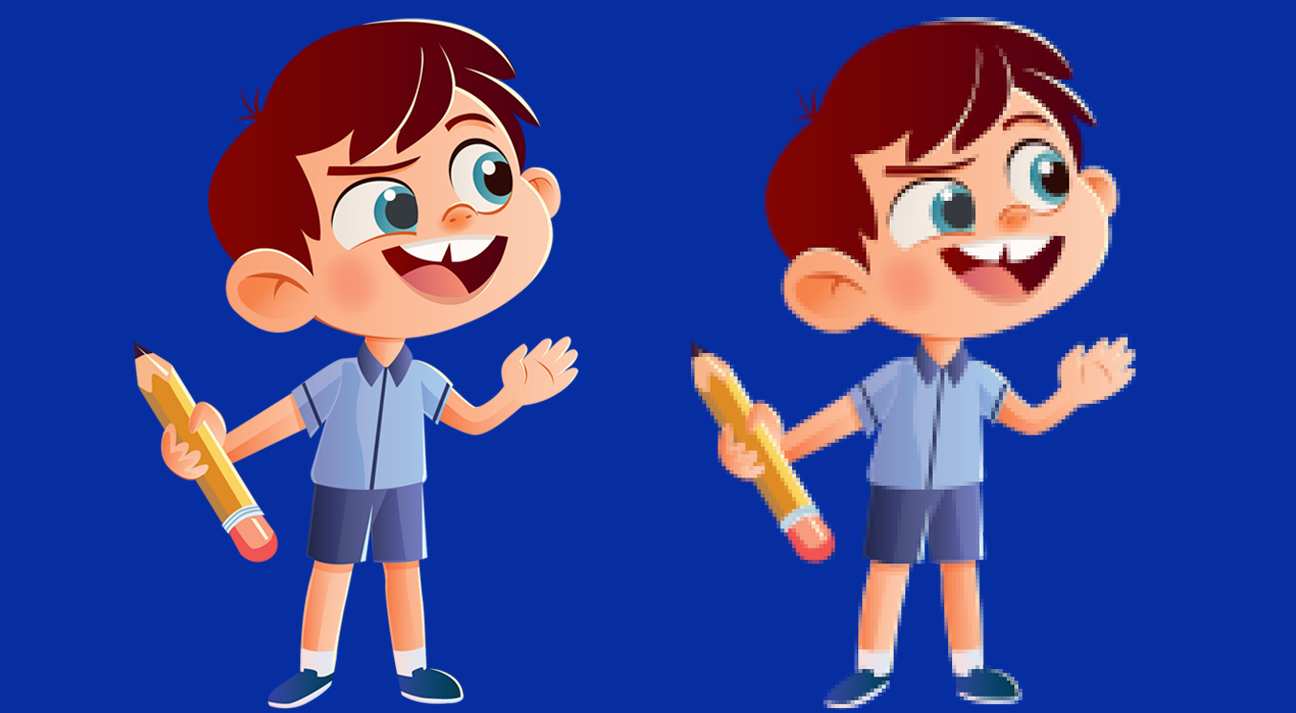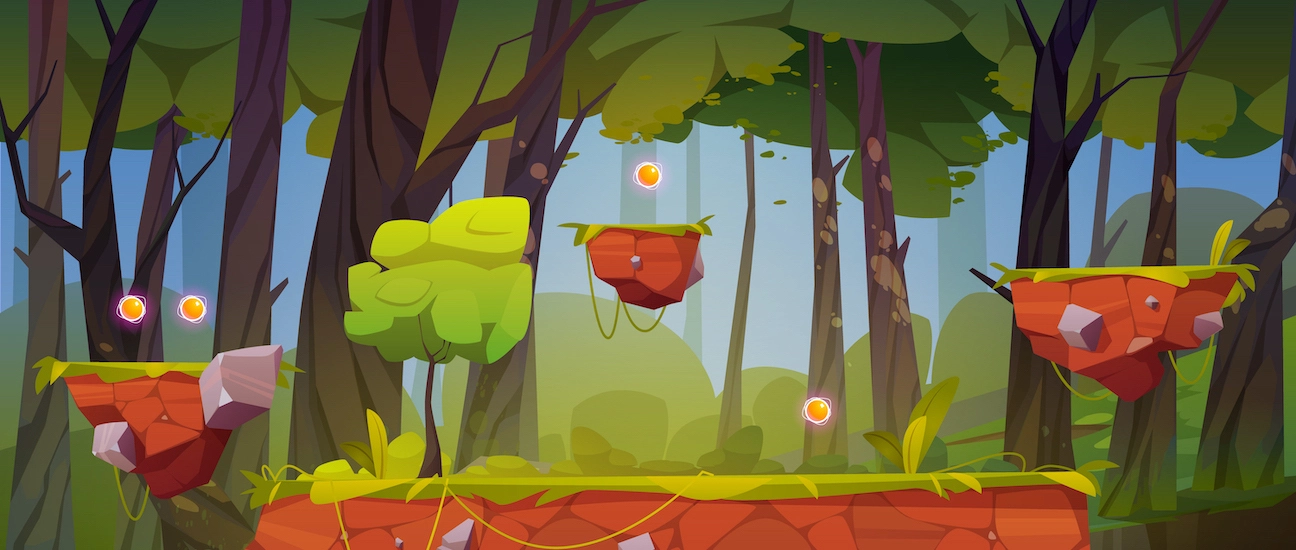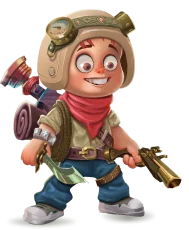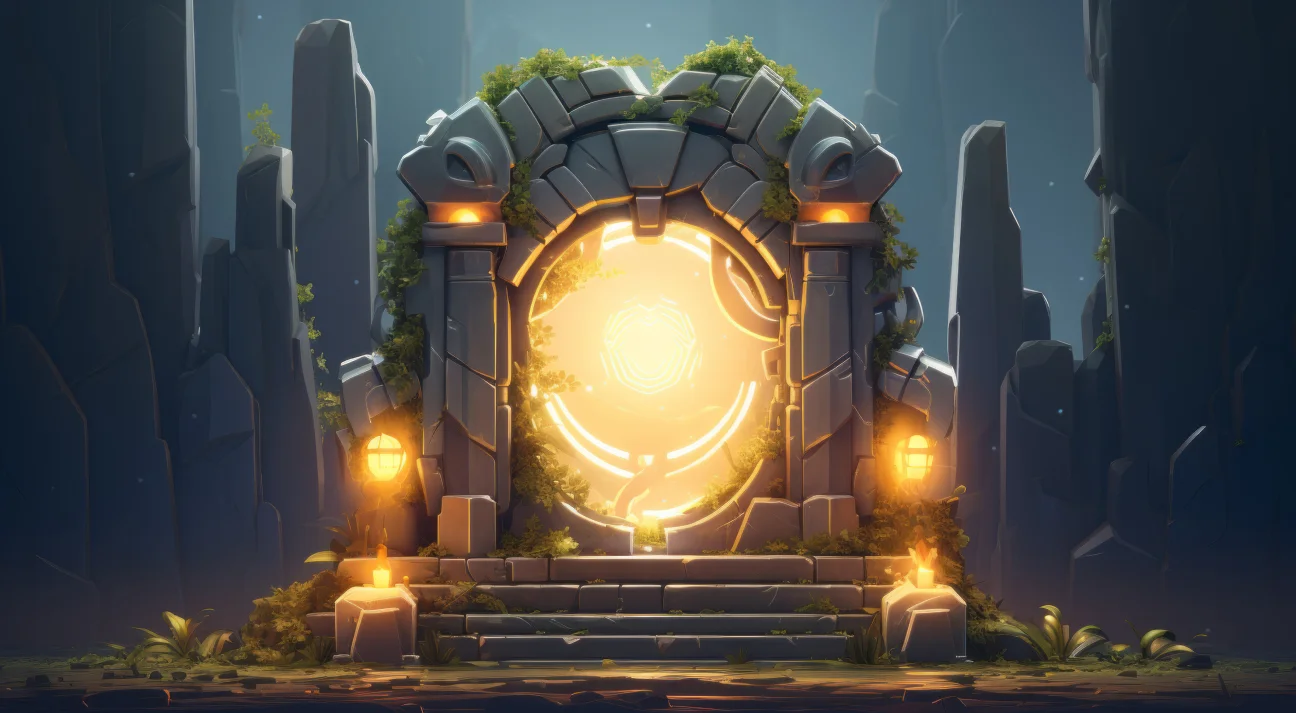
Vector vs. Raster Graphics: Choosing the Right Game Art
Game artists often face a dilemma when it comes to choosing the graphics or art for their game idea due to the availability of various types of art or graphics. And one of the most compared ones is Vector and Raster art or graphics. The gaming community has a lot of talks around this comparison and we are here to sum it all up for you.
In contrast to AAA games, the games utilizing Vector or Raster art have the intention to boast game development timelines and impose less strain on hardware resources. This inherent efficiency has made these graphic styles particularly appealing to varied game developers.
These creative minds can strategically leverage Vector and Raster graphics to streamline development efforts and to avail time and cost-effectiveness. Further, the simplicity and accessibility of Vector and Raster graphics prove instrumental for crafting engaging narratives.
Utilizing Vector and Raster graphics allows these creators to focus on storytelling and innovative gameplay, showcasing that impactful gaming experiences can be crafted without the extensive demands typically associated with high-end graphics. However, all these benefits can only be availed when either of these graphics you pick aligns with your requirements.
Before diving into the comparison of these two art forms, it’s essential to first grasp their fundamentals. So, let us understand each of these graphics individually.
- What is Vector Graphics?
- What is Raster Graphics?
- Vector vs Raster Graphics: Key Differences
- Vector vs Raster Graphics: Advantages and Disadvantages
- Vector vs Raster Graphics: The Tie Breaker
- When to choose Vector Graphics?
- When to choose Raster Graphics?
- Level Up Your Visuals with 300Mind’s Game Art!
- FAQs on Vector and Raster Graphics
What is Vector Graphics?

Anchored by dots/points and connected by lines and curves(also referred to as vertices and paths, these graphics art, or rather the shapes formed are a result of mathematical equations/formulas. each shape’s mathematical formula comprising its unique color, the gradient can’t be achieved.
Also known as scalable vector graphics (SVG), are crisp and sharp at any scale owing to the mathematical representations. Offering the ability to maintain the quality of your game art regardless of the device or resolution. The greatest challenge that game designers or artists face is achieving color transitions, shades, and shadows.
Use Cases of Vector Graphics
Vector graphics can be used in all the game art aspects which require visual aesthetics as well as the ability to sustain its clarity regardless of scaling.
Here are some key use cases of vector graphics in-game art:
- User Interface (UI) Design: Whether it’s crafting icons, buttons, or other UI components, Vector graphics are used for crafting visually appealing and scalable UI elements.
- Character Design: Vector art can be used for facial features, intricate costumes, or expressive gestures, vector graphics empower designers with the flexibility and precision needed to bring characters to life.
- Illustrations and Concept Art: When crafting detailed and imaginative illustrations, artists benefit from vector graphics’ ability to easily edit and refine their creations.
- Vector Animation: The precision of Vector Graphics allows seamless transitions, rotations, and transformations in animations without sacrificing clarity.
- In-Game Maps and Diagrams: Using Vector graphics ensures that every map contour, icon, and intricate detail remains crisp and clear, regardless of how much you zoom in or out.
Along with these use cases, vector graphics are ideal for designing logos, icons, typography, complex graphics, and more. It is highly suitable for a wide variety of printed formats.
Examples: Star Wars, Tempest, Star Trek, Lunar Lander, Blade Runner, and more.
What is Raster Graphics?

These graphics are also made of tiny dots but unlike Vector graphics’ anchor points, these tiny dots are pixels. Also known as bitmap graphics, these graphics get a vivid and detailed appearance from square-shaped pixels. Each pixel is regularly spaced and each one carries a specific shade enabling the design to create nice and smooth color blends.
Pixels are the fundamental aspect distinguishing these graphics from Vector as the number of pixels in each image or graphic is fixed. As a result of which, the image gets blurred when resized due to the stretching of pixels.
Use Cases of Raster Graphics
Key applications of raster graphics in game art include the following:
- Photorealistic Elements: From crafting captivating scenes and lifelike characters, the pixel-rich nature of raster art brings a heightened sense of realism to game visuals.
- Character Sprites: Raster graphics excel in capturing the nuances of characters, showcasing facial expressions, clothing textures, and fluid motion.
- Environmental Details: The specificity and richness required for environmental details like foliage, terrain textures, and atmospheric effects are better achieved with Raster graphics.
- Textured Realism: These graphics excel at capturing intricate details, lifelike textures, and nuanced shading, allowing game developers to breathe life into game characters, environments, and objects by conveying subtle variations in color, shadow, and texture.
Along with the above uses, Raster graphics are further used for photography, recalibrating images, designing websites, and more.
Examples: Super Mario Bros., Hang-On, and more.
Vector vs Raster Graphics: Key Differences

In the world of gaming, each pixel and vector plays a crucial role in shaping the player’s experience. It makes understanding the key differences between these two graphic formats paramount.
The following table will serve as your guide, presenting a concise and comprehensive overview of the distinctive features that set these graphics apart, enabling you to make informed decisions for your game art.
| Vector Art | Raster Art |
| Uses mathematical equations to create shapes | Composed of pixels |
| Fast-to-load SVG animations | Complex color blends |
| Digital line art | Complex compositions |
| Cost more | Cost less |
| Cartoonish graphics | Realistic graphics |
| Graphics occupy less space | Occupy more space depending on graphic quality |
| Scalable to any size | Not that scalable |
| Limited editing without loss of quality | Enables detailed editing |
| Graphics made with micro-interactions( UI elements) | Graphics made with digital texture brushes |
| Simple and geometric designs | Detailed and complex images |
Remember, the choice between vectors and rasters isn’t just about pixels and paths; it’s about crafting an immersive gaming experience!
Vector vs Raster Graphics: Advantages and Disadvantages
The choice between Vector and Raster Graphics holds significant implications for the outcome of visual creations. Each approach brings its unique set of advantages and disadvantages to the table, shaping the way game artists and designers craft everything from illustrations to game art. Let us now explore some of the strengths and limitations of both.
Vector Graphics
Following are the most important benefits and drawbacks of vector graphics that you should check before choosing them:
Advantages of Vector Graphics
- Device-independent graphics: These graphics allow game developers to create graphics once and seamlessly adapt them to different platforms without worrying about pixelation or loss of detail.
- Well-suited for UI design: The precision of vector graphics also allows for the creation of crisp, clean lines and shapes, enhancing the overall aesthetics of the user interface.
- Clean and crisp output: Vector graphics are based on mathematical equations, allowing for precise rendering of shapes and lines for the creation of sleek user interfaces, sharp text, or intricate game assets.
- Perfect for typography: Vector graphics excel in handling typography with precision and clarity, ensuring that text appears sharp and legible at any size or resolution whether it is in-game interfaces, menus, or textual elements.
- Consistency in design: Regardless of the size or resolution, game elements/assets created with vector graphics maintain a uniform look/feel or seamlessly integrate into the overall visual theme.
Disadvantages of Vector Graphics
- Resource-intensive for certain styles: When it comes to intricate details, textures, and complex visual styles often found in modern games, the computational demand increases. Rendering elaborate vector-based images with numerous details can strain system resources, impacting performance.
- Not ideal for complex texture: These graphics are composed of mathematical equations defining shapes, which makes them more suitable for simple, stylized graphics rather than the intricate patterns and nuanced surfaces often required in-game environments.
- Limited browser support: Not all browsers fully embrace the advanced features or specifications of vector graphics; these graphics are often created using formats like SVG (Scalable Vector Graphics) which might face some limitations in certain browsers. It potentially leads to inconsistencies in how the graphics are displayed.
- Beginner-challenging: For beginners, the learning curve may be steeper as they navigate the intricacies of manipulating vectors(by anchor points, curves, handles, and more) to achieve desired forms.
Raster Graphics
Here are the most important pros and cons of raster graphics that you should check before choosing them:
Advantages of Raster Graphics
- Good for the web: The pixel-based nature of raster graphics offers the ability to handle detailed and intricate designs, making them well-suited for web-based games where rich and lifelike graphics are essential as every element is finely rendered, contributing to a more immersive and visually appealing gaming environment.
- Beginner-friendly: Whether it’s painting characters or designing intricate backgrounds, the easy learning curve of raster graphics provides a solid foundation for those taking their first steps into the exciting realm of game art.
- Rich visual depth: Raster graphics, with their pixel-based structure, excel at capturing intricate details, subtle shading, and nuanced color variations. This level of detail allows game artists to create visually immersive environments, lifelike character designs, and vibrant textures.
- Artistic effects: These graphics allow for meticulous control over elements like lighting, shadows, and color gradients, enabling game artists to craft a visually stunning gaming experience.
Disadvantages of Raster Graphics
- Loss of details upon enlargement: When enlarged significantly, the lack of pixel-based information in vectors can result in a loss of finer details, impacting the visual richness and intricacies of the artwork.
- Limited animation options: While vector graphics are excellent for static or simple animations, their capacity for handling highly dynamic and intricate movements is limited, posing a challenge for game developers seeking more intricate motion in their designs.
- Constraints in user interface design: The challenge lies in the intricate nature of UI elements, where precise detailing and pixel-perfect alignment are crucial. Vector graphics, being inherently smooth and scalable, might lack the level of fine detail and pixel-level control required for intricate UI components.

Vector vs Raster Graphics: The Tie Breaker
This showdown clarifies the decision-making process, highlighting the strengths and weaknesses of each graphic type.
Whether you’re aiming for scalability, impeccable detail, or a blend of both, this tie-breaker will unravel the key distinctions, helping you make the right decision. Let’s dive in and discover the winning strokes in the Vector vs Raster battle!
| Parameters | Vector Art | Raster Art |
| Resolution independence | Yes | No |
| Scalability | Yes | No |
| Animation | Limited | Yes |
| Editing Flexibility | Yes | No |
| Performance-friendly on the web and on mobile | Yes | No |
| Detail and realism | Yes | No |
| UI design focused | Yes | No |
Furthermore, here are some more considerations that you can make when choosing either of these graphic types for your game art.
When to choose Vector Graphics?
If you are a game artist with flexibility and scalability as your top priority, the best choice for your game art is Vector graphics. Further, in recent times, gamers prefer to experience their favorite games on various platforms (iOS, Android, etc.) or screen sizes( mobiles, iPads, desktops, etc). Vector graphics being resolution-independent enable scaling your game across platforms or screen resolutions without compromising visual quality.
Apart from the sleek and modern aesthetic, vector graphics enable the game artists to add detailed textures, realistic rendering, and certain types of animation styles.
When to choose Raster Graphics?
Raster graphics provide the necessary precision if your game involves complex scenes, such as rich landscapes, immersive environments, or detailed character features. It is the best-fit choice when the artist’s top priorities are realistic visuals with great details. As pixel-based images are ideal for capturing the nuances of textures like fur, skin, or intricate backgrounds, providing a level of realism.
As far as dealing with continuous tones is concerned, Raster Graphics is the go-to choice for projects where smooth gradients and intricate color variations are crucial. However, it is essential to consider the potential trade-offs, such as larger file sizes and limited scalability, when making this choice for your game art.
If you’re still unsure about which one is the best fit for your game idea, our game artists are here to provide personalized consultations tailored to your needs. Just drop us a message and our team will reach out to you in no time. We’re here to bring your vision to life – don’t hesitate to reach out!
Level Up Your Visuals with 300Mind’s Game Art!
Embarking on the journey of game art creation demands a blend of creativity, precision, and technical expertise, and at 300Mind, we pride ourselves on being your unparalleled partner in this endeavor. We understand the unique demands of the gaming industry and provide bespoke solutions that cater to your diverse game design creation needs.
Our team of skilled game designers for hire brings imagination to life, crafting visually stunning and immersive game environments. With a dedication to excellence, our game designers seamlessly blend innovation and expertise, ensuring that every pixel tells a story.
With a commitment to excellence and a knack for pushing artistic boundaries, 300 Mind transforms concepts into masterpieces. Contact us today and let’s embark on a journey of creativity together.
FAQs on Vector and Raster Graphics
Adobe Illustrator, Inkscape, CorelDraw, Affinity Designer, and more are some of the software used for creating Vector graphics.
Some of the software used for creating Raster art are Adobe Photoshop, GIMP, Corel Painter, and more.
To combine vector and raster graphics, use graphics software that supports both formats, like Adobe Photoshop or Illustrator. Create vector elements for scalability and precise shapes, then incorporate raster images for detailed textures and effects. This dynamic duo allows for the best of both worlds in terms of flexibility and detail, resulting in high-quality and versatile designs.
Well, one of the easiest ways to tell the difference between Vector and Raster graphics is – if the image maintains crispness when resized, it’s likely vector; if pixelation occurs, it’s raster. Additionally, check file types – vector graphics are typically SVG or AI, while raster graphics are JPEG or PNG.








